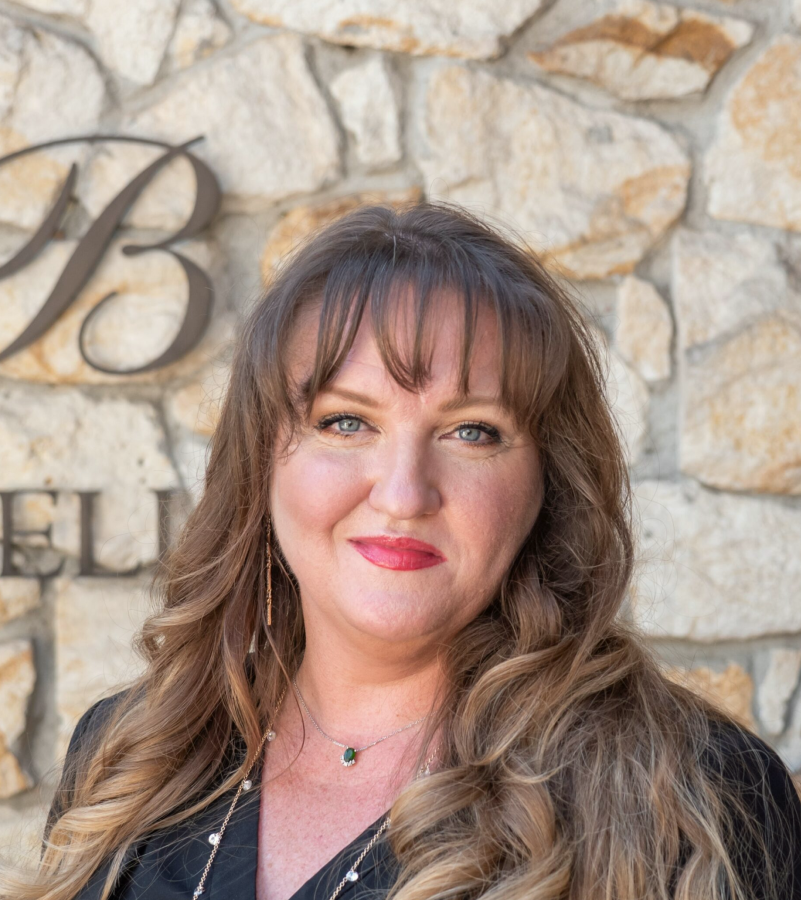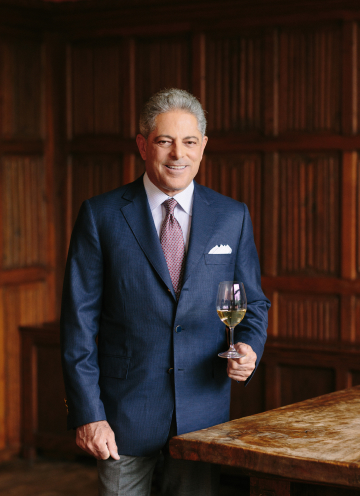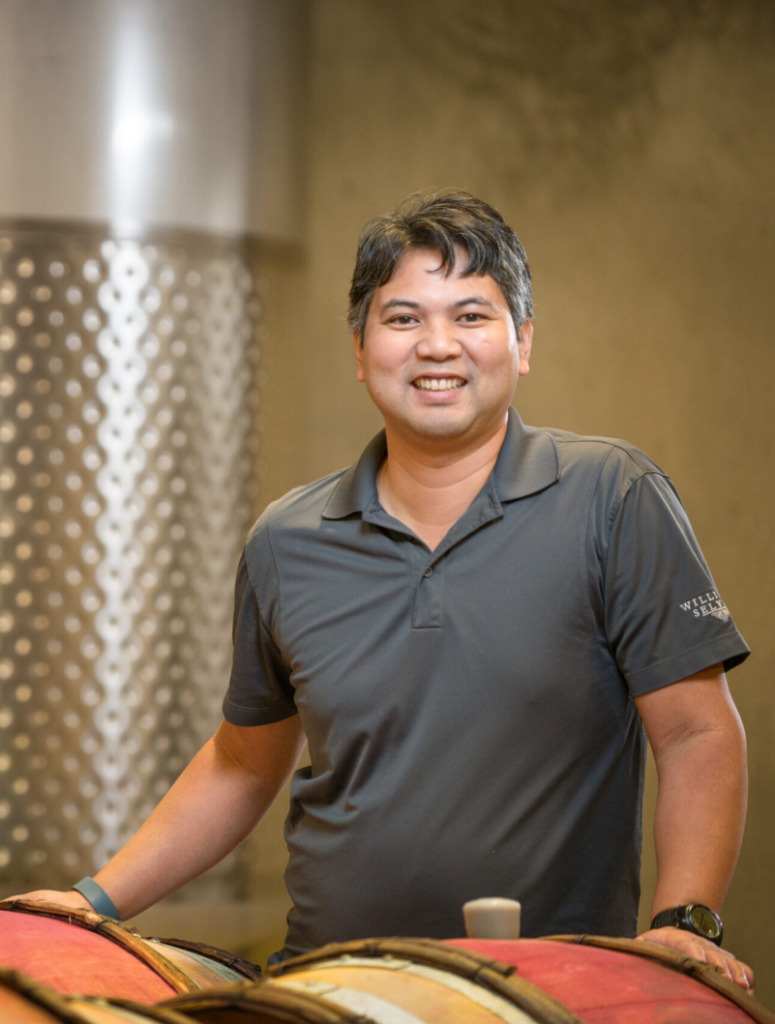"When we think of the success of a brand, we make decisions allowing success to be measured in decades, not in years or even quarters."
Could you please give us an overview of Bell Wine Cellars as it stands today?
Bell Wine Cellars is a family-owned, very small boutique winery. We produce about 10,000 cases a year. We’re very proud to remain family-owned. That’s getting harder and harder to find, obviously, in Napa Valley. We started as initial researchers of how each individual single clone of the Cabernet Sauvignon grape reacts to different environments in our area. Usually, when you think about the clones of different grapes, it’s in relation to Pinot Noir or Chardonnay, and it is a very Burgundian thing. It’s not uncommon for even growers to have rows and rows of Cabernet Sauvignon without necessarily understanding what clone of Cabernet is in there. Each of these clones of Cabernet Sauvignon or any grape reacts differently to different soils, geography, and climate of where they are.
So, we started with researching how these different clones react. And that was under a winemaker named Anthony Bell at the time. Anthony Bell has since retired, but our ownership and our winemaker, John Hazak, have continued that research. And over our 30 years, we’ve continued that research. And we’ve become Napa’s really foremost researchers of clonal Cabernet. We are Napa’s largest producer of single-clone bottlings of Cabernet Sauvignon.
So, we currently work with seven different clones that we’ll bottle singularly, and each of these clones has very specific qualities about them. For instance, Clone 6 has a lot of typicity about it. It’ll bring in that kind of herbaceous nature. Clone 337 has a lot of florals to it. Clone 169 is very dark and brooding and has a lot of those dark blue fruits. Each of these clones is singular when we’re talking about different textures to the resultant wine, different structures, different aromatics, and different flavors, even though they are themselves still Cabernet Sauvignon and still grown throughout Napa Valley.
So, when conditions exist for any of the clones, we will bottle them separately. What ended up happening was that we actually did a master class on the single clones at the San Francisco Wine School for a bunch of sommeliers last August. But if you line all the clones up out of our portfolio of seven into a flight and taste them singularly, you really get to understand how different they are from each other. And then we have a reserve Cabernet Sauvignon that’s a blend of several of the clones where you get to see how they kind of pull together and piece in.
What’s been really interesting about this is that, obviously, climate change is a global issue. And by having this body of research, we’ve really been able to harness which clones we should gravitate to based on whether or not they’re being run under the correct conditions for us to bring them into our portfolio and our program and craft extremely well-balanced high-quality lines with them. That’s kind of the nuts and bolts of who we are.
That’s fantastic. You’re very well known for Cabernet Sauvignon. Could you recommend some of the wines that you would like our readers to know about?
Our single-clone program is absolutely our flagship. As for personal favorites, we each have ours. For example, I think our 337 should be in everybody’s cellar. The Clone 7 is another one that is incredibly well-balanced, so just very powerful 338 and 169. I don’t know. It’s kind of hard to choose. It just depends on what you’re looking for. But they just perform so well when the conditions are correct.
And, of course, if the vintage doesn’t provide climate-wise, weather-wise what’s necessary for those clones to be able to be bottled singularly, then we won’t bottle it. If it needs the support of one of the other clones to come together, then we won’t bottle it on its own. But we are finding that because of the research that we’ve done, we are able to be very precise and exacting about when a clone can be bottled on its own and when it shouldn’t be. But you know, I guess the short answer is if you’re asking for a personal favorite, 337 is a personal favorite that should be in everybody’s cellar.
Alright! You mentioned that you are leading the pack in terms of research, and I would like to know a little bit more about your production methodology, such as route handling and minimal intervention. Could you tell us a little more about that as well?
Well, our winemaker, John Hazak, yes, he’s a minimal interventionist. He does not like to use additives and things like that. He really likes the grape to be able to show on its own, which is kind of the broad acceptance that winemaking begins in the vineyard, which is very true. Sometimes, a wine does need a little help, or a vineyard does need a little help. But John, even in some of our lower-end wines, is very passionate about letting the grape be what the grape is supposed to be, and that includes leaving out the additives and just letting the whole process come about naturally.
Understood. And I would like you to tell us a little bit more about the Bell Estate for those that would like to visit it as well.
Okay. As far as the Bell Estate goes, we are in the Yountville sub-AVA. Napa has 16 nested or sub-Appalachian within the valley, so we’re in the Yountville Appalachian about a mile south of Yountville’s cute little downtown area. The French Laundry is in downtown Yountville, so we’re just about a mile south of that.
We are a state winery. We have about 5 to 6 acres of grapes planted, and then we do our production on-site. Our tasting room is also on-site. As far as tastings go, we’re private and by appointment. We don’t have a public tasting bar or anything like that.
Our staff are seasoned sommeliers. In fact, two of them came with me from a Michelin-level restaurant. I used to run the wine program for a Michelin-level restaurant in Sacramento, and I brought two of my top sommeliers with me when I got to Bell. And so we’re also very passionate, not only about doing the research but also about having staff who can articulate how that research applies to the wines and explain it and share it with guests when they come in.
That leads me to my next question. Sensory tasting could be quite an educational experience for our readers. So, would you please tell us a little more about the events that you host?
Absolutely, one of the things that we are very specific about is our tastings. It’s very normal to go to tastings throughout Napa Valley and other regions. I spend a month a year in France, and I usually go to Champagne, which is my first love. But in regions, typically when you’re doing wine and everything, you get the tasting note with like what aromas you’re smelling and what flavors you’re getting. And yes, those are very important. But I think what supersedes those in importance is a wine structure.
If a wine smells like raspberry, that’s not going to tell you anything about what it will pair with as far as food goes or how long it will age. You don’t understand how to pair food and wine or how to apply wine to your life and your seller unless you understand its structure. The reason why I say that is because acid and tannin are really what lead to a wine’s food pairing capability and what food you will pair with it, and those also inform how long you can age the wine.
For our tastings, of course, we get into the geography of where the grapes were grown and everything like that when we get into the aromatics and the flavors. But what we start with is teaching people how to differentiate your mouth’s physiological reaction to the structural components of acid, tannin, and alcohol. Nobody’s born knowing how to taste wine. It’s a learned thing, just like surgeons aren’t born knowing how to cut somebody. And I’ve found throughout my career that people who haven’t been formally taught how to taste wine and even how to smell a wine, and where to put your nose in a wine glass that they’ll confuse the vocabulary or the sensations between acid, tannin, and alcohol.
So, acid, for instance, is going to be the component that causes the salivation in your mouth and being able to teach somebody. Let’s just focus on that piece first. The longer that salivation goes on, the higher the acid level is. For tannin, when you feel that drying sensation on your tongue, it is more tense. That’s going to be your tannin. And that alcohol is going to be the burning that goes down your throat or when you blow air across your tongue.
We start by breaking it down to that very baseline level. To start with structure, let’s start with those three very subjective things because aromatics and flavors can be very subjective, while structure is very objective. You can actually assign a value or assign a number to it. And so, our tastings, once we get to the table, start with that. We always do a tour through the vineyards and the barrel room as well.
Once we get to the table to taste, we start by making sure that our guest understands how to smell, as a wine glass again has three different aromatic zones. And what you’ll typically find is that when somebody is smelling their wine, their nose goes straight to the bottom rim, which is normal. That’s normal. It’s intuitive because that bottom rim is closest to your mouth. But the only thing you get when you smell from the bottom rim is just alcohol because alcohol is the heaviest component of the liquid in the glass. So that’s the only thing that’s wafting up. You can line up a flight of wine and just smell from the bottom rim, bottom rim, and bottom rim; you won’t get that much aromatic difference. If you smell in the dead center of the glass, which is also normal, the only thing you’re picking up there aromatically is oak in fluids. And so any wine that’s been treated with oak, again, it’s going to smell very similar from one to the other. But when you concentrate your nose on the top rim, you like to bring the glass up to drink, and you adjust so you smell in the top rim; that’s where you get the actual expressions of that line’s aromatics. That’s where you get the fruits, the florals, and the herbaceousness. That’s where those things live.
Given that 85% of what you taste comes from what you smell, we start with making sure first that everybody is putting their nose in the right part of the glass, and then from there, there’s teaching them how to assess the wine’s acidity, assess the wine’s tannins, and assess the wine’s alcohol. Then, we go into a discussion as to why those components are so important as they’re tasting the wines. So that’s pretty much thorough.
That’s a great explanation. And, Hilary, is there anything I haven’t asked you about that you would like to bring up and mention?
No, we pride ourselves on being a small family-owned business that puts everything into making sure that the wine in the bottle is of very high quality and well-balanced.



















